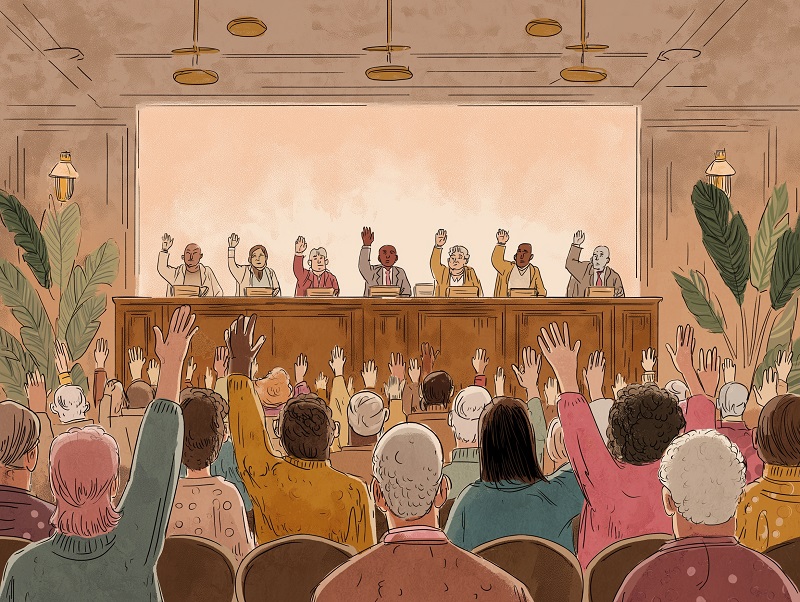
The thing about Santa Monica is that it has always believed its own marketing. Tech capital of the west side. Innovation hub. The place where startups come to die beautiful, well-funded deaths while their founders drink $18 cold brew and complain about parking. But somewhere between the billion-dollar tech unicorns and the homeless encampments, the city’s political class developed a peculiar habit: they began to see many of the people who elected them as a bug, not a feature.
This was happening long before anyone had heard of ChatGPT. The Santa Monica city government had perfected a particular kind of performance art—democracy as dinner theater. Real votes often happened after 11 PM, long after working parents had gone home. Important stuff would get buried in 500-page reports written in the kind of bureaucratic English that makes Kafka look like Dr. Seuss. They would nod solemnly during public comment, then do exactly what they planned to do anyway.
It worked, often, because information asymmetry is a politician’s best friend. The councilmembers had staff, lawyers, and consultants. The residents had jobs, kids, and mortgages. Guess who had time to decode municipal bond measures at midnight?
And now artificial intelligence has shown up to the party.
The first thing AI does is ruin everyone’s favorite game: complexity theater. Those 500-page planning documents? A decent AI language model, properly set up and supplied with staff reports and data, can now summarize them in about thirty seconds, cross-reference them with voting records, and flag the parts where the rhetoric doesn’t match the policy. The dense technical language that used to protect bad decisions–gone. AI doesn’t get confused by jargon. It doesn’t get tired at 11 PM. It doesn’t have to leave early to pick up kids from daycare.
Picture this: It’s Wednesday morning. Your phone buzzes. Not news, not gossip—just the scoreboard: “Santa Monica City Council voted 5–2 last night for the Luxury in the Sky highrise project on the Third Street Promenade.” And then the numbers pop up. What it means for your rent-controlled apartment, your water bill, your taxes. Who voted yes. How much the developer paid them. What they promised on affordable housing last year, and whether any of it actually happened.
That’s the feed. Instant accountability. Is it here yet? No (but give it a minute or two). The beautiful thing about AI is that it doesn’t care about your feelings. It just reports what it finds.
The real magic happens when you flip the script. For years, the Council’s superpower was knowing what residents thought while pretending they didn’t. They could safely ignore a few dozen angry emails because they knew that a few dozen angry emails represented many annoyed constituents who just didn’t have time to write. The silence was their permission slip.
AI kills the silence. Suddenly, platforms can (or will be able to) collect and analyze sentiment from thousands of residents in real time. They can slice the data by neighborhood, by age, by income. They can show exactly who supports what, and why. When 70% of District X opposes a zoning change, and the Council approves it anyway, the phrase “representing our constituents” starts to sound like performance art.
The predictive modeling is where things get really uncomfortable. Councilmembers love to make grand promises about what their projects will accomplish. This development will ease traffic. This ordinance will help the homeless. This zoning change will create affordable housing. It’s all very confident and completely untestable—until now, or a short time from now.
Soon, easily available AI will run the numbers. Feed it traffic patterns, costs, housing data, local economics, demographic trends, and it will tell you what’s actually likely to happen when you approve that large new hotel on Ocean Avenue. Not what the developer says will happen. Not what the Council claims will happen. What may actually happen.
The uncomfortable truth is that many municipal decisions are terrible bets disguised as civic improvements. AI makes the disguise harder to maintain.
Of course, the same technology that can expose bad governance can also enable it. Predictive policing algorithms that happen to target certain neighborhoods. Engagement platforms that amplify supportive voices while burying criticism. AI-generated content flooding social media with synthetic enthusiasm for deeply unpopular policies. Santa Monica’s government—and plenty of others—may find these little tricks hard to resist. But trying to game policies in a city full of smartphones is like hiding cookies from a ten-year-old. You might get away with it for a minute. Then the jar’s empty, and everyone knows who did it.
This is the choice that members of Santa Monica’s government face, though they probably don’t realize it yet. They can use AI to become the transparent, responsive government they’ve always claimed to be. Help residents understand complex issues. Model policy outcomes honestly. Share power instead of hoarding it (fix the city’s Open Data Portal, to take but one example).
Other cities around the world are already experimenting with this idea, successfully:
Helsinki, Finland: https://ai.hel.fi/en/ai-register/
Seoul, South Korea: https://tinyurl.com/knyh5ev5
Barcelona, Spain: https://tinyurl.com/47446z2x
Taiwan: https://tinyurl.com/mwcdha3j
Amsterdam: https://tinyurl.com/mwem3mp9
Or they can keep playing the old game, and discover that artificial intelligence has a way of turning small fibs into big problems, bad decisions into civic disasters, and ignored constituents into organized opposition.
The algorithm doesn’t care about your reelection. It doesn’t care if you’re chummy with Sacramento lobbyists. It cares about patterns, predictions, and what the data actually says. In Santa Monica, where people treat every bench, tree, and parking spot like a constitutional crisis, that might be a big problem for City Hall. Or it might be exactly what democracy has been waiting for.
Daniel Jansenson, Architect
For SMa.r.t.
Santa Monica Architects for a Responsible Tomorrow
Robert H. Taylor, Architect AIA; Thane Roberts, Architect; Mario Fonda-Bonardi, Architect AIA (former Planning Commissioner); Sam Tolkin, Architect (former Planning Commissioner); Michael Jolly AIRCRE; Jack Hillbrand, Architect AIA, Landmarks Commission Architect; Daniel Jansenson, Architect (former Building & Fire-Life Safety Commissioner); Phil Brock, Santa Monica Mayor (ret); Matt Hoefler, Architect NCARB












